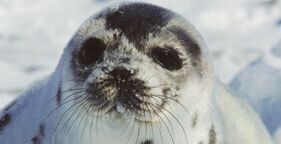The Gulf of St. Lawrence on Canada's Eastern seaboard is a wild, unforgiving place, subject to extreme weather and partially covered with sea ice for much of the winter.
It's also a vitally important habitat for a huge variety of marine animals.
At this time of year, it's particularly important for harp seals, who haul out onto the sea ice at the end of every winter to give birth to their pups in one of nature's most remarkable events.
Their mothers stay with the pups for a few short days, feeding them high fat milk, after which the adults head back to sea leaving the pups on the ice. In these 'seal nurseries,' the pups fast for weeks, living off their fat reserves from their mothers' milk, until they are strong enough to survive in open water.
However, the future of these seal populations is threatened. Climate change is reducing the extent to which the winter sea ice forms and the ice is melting ever earlier, meaning mothers have less ice on which to give birth. The helpless pups can die as their icy platform melts away. The past few breeding seasons have been disastrous and seal numbers are declining.
Yet every year, fishermen armed with rifles and spiked clubs head out in boats with the intention of killing up to hundreds of thousands of the seal pups for their fur pelts.
For nearly a decade, Humane Society International's Protect Seals team has travelled out to the ice to document this cold-bloodied killing to bring it to the attention of the rest of the world.
Often faced with intimidation from the sealers and obstructive government officials, our team has witnessed the most appalling cruelty over the years. In spite of claims by sealers that the slaughter is humane, seal pups are often impaled on metal hooks, dragged across the ice and cut open whilst still conscious. Still more take to the water after being shot or clubbed, only to die in the icy sea.
The sealers took to their boats again this March. Although, on average, the seal slaughter provides them with only a tiny fraction of their annual income, they did so with the support and complicity of the Canadian federal government. In fact, Canada's commercial seal slaughter is so unprofitable that the Canadian government actually subsidises the suffering to keep it going in the face of growing international boycotts and condemnation.
In an incredibly cynical move, the Canadian authorities set a massive 'quota' of 400,000 seal pups who could be slaughtered in 2012, despite warnings from senior Canadian scientists that the quota should be reduced because of the lack of sea ice.
An increasing number of countries around the world are appalled by the cruelty of commercial seal slaughters and the threats they pose to seal populations.
The United States, Mexico, Croatia and the European Union have all prohibited trade in seal products. In 2011, the Russian Federation, Belarus and Kazakhstan announced a ban on the import and export of harp seal skins. Many more nations including Switzerland and Taiwan are moving towards similar legislation.

However, rather than respect this growing international opposition to the killing and recognise that it is time for a 'buy-out' of sealers' licenses, the Canadian authorities continue to support the bloody slaughter. Most Canadians and many sealers support such a buy out. With nations closing their borders to Canada's cruel seal products, Canadian trade delegations, funded by Canadian taxpayers, are seeking new markets in the far East. The Canadian government is even fighting to have the European Union's ban on seal product trade overturned by challenging it through the World Trade Association.
Canada's WTO challenge is one that strikes at the very heart of EU's right to reflect the moral wishes of its own citizens and to restrict trade in products of cruelty. This challenge has angered many on both sides of the Atlantic, and Members of the European Parliament have called for the Free Trade Agreement under negotiation between Canada and the EU, which will be worth billions of dollars, to be put on hold until Canada withdraws its WTO challenge.
Ironically, the cost to the Canadian taxpayer of funding this legal challenge will total many times the value of the sealing industry itself.

Humane Society International and others have long been campaigning for an end to the annual Canadian seal slaughter, and other cruel seal hunts around the world.
A growing number of businesses, restaurants and individuals in North America and Europe have pledged to boycott Canadian seafood products until the harp seal slaughter is ended. This amounts to many millions of dollars worth of trade lost from the Canadian economy each year, yet the Canadian authorities appear to prioritise killing seals over benefiting their own citizens.
The Canadian sealing industry is fast running out of markets for its products and it's high time the Canadian government stopped wasting its taxpayers' money. The government must bring the annual seal slaughter to an end and move forward by developing sustainable alternative livelihoods for the people of Newfoundland and other Atlantic provinces.
Learn more about the cruel Canadian seal slaughter, and learn how you can help protest this pointless slaughter of harp seal pups.
